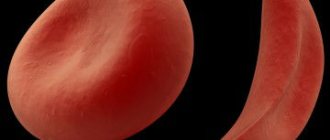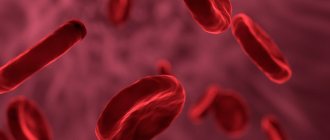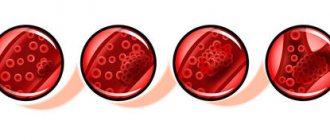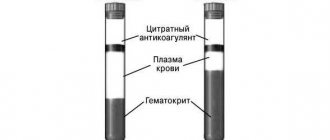At an appointment with a pediatrician, parents often receive a referral for a general blood test, which is done to check the quantitative characteristics of the plasma. Parents are wondering what MCV is. This is the level of the state of red cells of erythrocytes in the biomaterial. If the value is less than normal, this means that the average volume of red blood cells in the child is reduced.
Study
The number of red blood cells is determined by a complete blood test.
Often in the result form you can find a line mcv with some numerical indicator, which means the average number of red blood cells. The name MCV comes from the English mean corpuscular volume, and the unit of measurement is usually considered to be a cubic micrometer or in fl - femtoliter. To calculate, take the average volume of red blood cells (ESR), which is then divided by the sum of the volumes of red blood cells in a portion of blood by their number in a given portion.
In the case where the average volume of red blood cells is reduced, a number of additional, more highly specialized studies are carried out to find out what this means and what deviations could lead to this.
Currently, there are additional tests when the mcv value in the blood decreases. These include the average hemoglobin content in a red blood cell, the values of which vary depending on the age of the patient and are absolutely independent of his gender. The size and color of blood cells are also analyzed for the volume of blood being tested.
Red blood cell indicators are:
- increased value, then this is called macrocytosis (100 or more) - red blood cells are larger than necessary,
- normal value – normocytosis (80-100),
- low value – microcytosis (80 or less).
The average volume of red blood cells in the blood varies depending on the patient's age. So, for example, for a newborn it is 95-121 fl, and already on the 14-30th day of life it is 88-124 fl. Children aged 1-5 years should have 73-85 fl, and for an adult 20-65 the norm is 80-100 fl.
Normal values
The complete blood count contains the MCV value, or the mean volume of red blood cells in the blood. If the MCV is low, then the size of the red blood cells is lower than normal.
Doctors judge the normality or decrease in the volume of red blood cells quite arbitrarily. The size of the red blood cell changes even during the day due to physiological reasons: after work, a tired person’s blood cells increase in size, and after rest they become smaller. At 8 o'clock in the morning, when most tests are carried out, the size and volume of the bodies reaches a minimum.
The volume of red blood cells and their size in an adult are determined in femtoliters (fl) or µm³. Normal values change throughout life. In middle age (40-59 years) they range from 80-100 fl for women and 81-94 fl for men. Indicators in younger patients differ slightly (a little more), so 80 fl is most often taken as the average norm. In men over 65 years of age, the normal value can range from 78-103 fl.
Red blood cells with normal volume are called normocytes, and those with low and high volume are called micro- and macrocytes, respectively. The size of the cells is regulated by the body itself depending on their number in the blood: if there are a lot of red blood cells, then the MCV is lower.
Important information: What are B-lymphocytes in a blood test?
Normal for a child
In the first month of life in children, the normal size of a red blood cell is more than 105 fl. By six months this value drops to 90, and by 1 year - to 78-80 fl. This is a normal physiological process during which fetal hemoglobin is replaced with the new one that adults have. At 5-12 years of age, the average volume indicators again increase slightly (up to 89 units), but by the age of 18 they reach the adult norm.
Reduced value
If the average volume is reduced, they speak of anemia, i.e. a lack of hemoglobin in the blood.
The most common reasons when red blood cells are below normal are:
- Iron deficiency or iron deficiency anemia. This form of anemia occurs without complications and has the simplest treatment compared to other types of anemia. If a child’s hemoglobin is low and the cause is determined to be iron deficiency, the child is prescribed a special diet with a repeat blood test a month later. If a child’s hemoglobin does not increase after a month, but rather decreases, then in this case, he is referred to a hematologist and drug treatment is prescribed.
- Sideroblastic anemia. Also associated with iron deficiency, responds well to vitamin B6 therapy. This type of anemia develops quite rapidly and requires immediate action; the worst outcome of such a diagnosis can be death.
- alassemia is a genetic disease. Anemia is caused by impaired hemoglobin production.
- Lead poisoning. In case of lead poisoning, the average value of red blood cells decreases due to the fact that the bone marrow begins to fail and a disruption occurs in the body's production of hemoglobin.
- Dehydration of the body. This is due to the loss of fluid from the body, which negatively affects the blood test.
Sometimes there are situations when the average volume of red blood cells is not reduced, but is within the normal range, but clear signs of anemia appear. This often happens if there is:
- the presence of a malignant tumor,
- the presence of chronic infections,
- significant blood loss
- the presence of diseases that cause insufficient production of hormones.
If the mcv is lowered in the analysis, then a qualified consultation with the attending physician or hematologist is necessary.
Features of the analysis
Today, the mcv test is included in the general blood test or can be performed separately from other indicators. To donate blood, the patient must come to the treatment room, where a laboratory technician or nurse will take blood samples from a finger or vein. Blood sampling is carried out in accordance with all sanitary and epidemiological regulations (SanPiN).
The patient is required to comply with the following rules:
- You need to donate blood on an empty stomach (5-12 hours after your last meal);
- at the time of donation, the woman should not be menstruating;
- feeling normal. It is prohibited to take blood samples if the patient is not feeling well, is in a coma or is in cardiac shock.
Increased value
If the average volume of red blood cells is increased, this may mean a disruption in the body’s functioning. Reasons when mcv is elevated can be:
- Liver disease.
- defect in the functioning of the red bone marrow.
- The thyroid gland does not produce enough hormones
- Vitamin B12 deficiency. This deficiency has a particularly negative effect on children under 2 years of age. At this age, you need to focus on eating foods containing high amounts of vitamin B12, for example, sour cream, eggs, liver, beef and others.
- Folic acid deficiency.
- Smoking. Smoking releases a significant amount of carbon dioxide, which impairs blood transport in the body, leading to a deterioration in oxygen supply. Women who smoke are more susceptible to respiratory diseases, which can cause increased red blood cell counts.
- Oncological diseases.
- Taking contraceptive and hormonal medications.
- Inflammatory processes in the body. These can be infectious diseases caused by a virus or some kind of fungus.
- Alcoholism. In this case, the mcv indicator can be brought back to normal; to do this, it is enough not to drink alcohol for 100 days. It is worth saying that in this case only mcv values increase, and the hemoglobin value remains within normal limits.
There is a version that taking antidepressants for a long time can lead to increased levels, but at the moment this version is under study.
An increase in red blood cells in the blood may be temporary and not carry any abnormalities or pathologies. This situation can lead to:
- stress,
- being in high mountains,
- excessive mental or physical work,
- influence of toxins,
- dehydration.
After these factors are eliminated, such important indicators of red blood cells as their average volume will return to normal.
Study
The number of red blood cells is determined by a complete blood test.
Often in the result form you can find a line mcv with some numerical indicator, which means the average number of red blood cells. The name MCV comes from the English mean corpuscular volume, and the unit of measurement is usually considered to be a cubic micrometer or in fl - femtoliter. To calculate, take the average volume of red blood cells (ESR), which is then divided by the sum of the volumes of red blood cells in a portion of blood by their number in a given portion.
In the case where the average volume of red blood cells is reduced, a number of additional, more highly specialized studies are carried out to find out what this means and what deviations could lead to this.
Currently, there are additional tests when the mcv value in the blood decreases. These include the average hemoglobin content in a red blood cell, the values of which vary depending on the age of the patient and are absolutely independent of his gender. The size and color of blood cells are also analyzed for the volume of blood being tested.
MCV below normal
Tests showing that the volume of red blood cells is below normal also indicates pathology. Experts name a number of reasons that can lead to such results:
- genetic predisposition;
- insufficient amount of water consumed;
- development of various types of anemia;
- lead intoxication;
- the presence of malignant formations, tumors in the body;
- taking medications that affect test results.
In medical circles, a disease in which the level of red blood cells in the body decreases is commonly called microcytic anemia. The peculiarity of the disease is that red blood cells do not perform their transport function, i.e. they do not deliver oxygen and other useful substances to the body’s cells in the required quantities.
With this pathology, a characteristic clinical picture is observed:
- constant fatigue;
- increased irritability, nervousness;
- decreased concentration and performance;
- absent-mindedness;
- memory impairment.
A decrease in the volume of red blood cells is always observed with various types of blood loss.
Pregnancy and mcv
During pregnancy, due to the body's increased consumption of iron, microcytic anemia can develop. This condition can negatively affect both the health of the unborn child and the well-being of the mother.
Some experts are convinced that mcv indicators are directly related to a person’s psychological state.
Reduced value
If the average volume is reduced, they speak of anemia, i.e. a lack of hemoglobin in the blood.
The most common reasons when red blood cells are below normal are:
- Iron deficiency or iron deficiency anemia. This form of anemia occurs without complications and has the simplest treatment compared to other types of anemia. If a child’s hemoglobin is low and the cause is determined to be iron deficiency, the child is prescribed a special diet with a repeat blood test a month later. If a child’s hemoglobin does not increase after a month, but rather decreases, then in this case, he is referred to a hematologist and drug treatment is prescribed.
- Sideroblastic anemia. Also associated with iron deficiency, responds well to vitamin B6 therapy. This type of anemia develops quite rapidly and requires immediate action; the worst outcome of such a diagnosis can be death.
- alassemia is a genetic disease. Anemia is caused by impaired hemoglobin production.
- Lead poisoning. In case of lead poisoning, the average value of red blood cells decreases due to the fact that the bone marrow begins to fail and a disruption occurs in the body's production of hemoglobin.
- Dehydration of the body. This is due to the loss of fluid from the body, which negatively affects the blood test.
Sometimes there are situations when the average volume of red blood cells is not reduced, but is within the normal range, but clear signs of anemia appear. This often happens if there is:
- the presence of a malignant tumor,
- the presence of chronic infections,
- significant blood loss
- the presence of diseases that cause insufficient production of hormones.
If the mcv is lowered in the analysis, then a qualified consultation with the attending physician or hematologist is necessary.
Increased value
If the average volume of red blood cells is increased, this may mean a disruption in the body’s functioning. Reasons when mcv is elevated can be:
- Liver disease.
- defect in the functioning of the red bone marrow.
- The thyroid gland does not produce enough hormones
- Vitamin B12 deficiency. This deficiency has a particularly negative effect on children under 2 years of age. At this age, you need to focus on eating foods containing high amounts of vitamin B12, for example, sour cream, eggs, liver, beef and others.
- Folic acid deficiency.
- Smoking. Smoking releases a significant amount of carbon dioxide, which impairs blood transport in the body, leading to a deterioration in oxygen supply. Women who smoke are more susceptible to respiratory diseases, which can cause increased red blood cell counts.
- Oncological diseases.
- Taking contraceptive and hormonal medications.
- Inflammatory processes in the body. These can be infectious diseases caused by a virus or some kind of fungus.
- Alcoholism. In this case, the mcv indicator can be brought back to normal; to do this, it is enough not to drink alcohol for 100 days. It is worth saying that in this case only mcv values increase, and the hemoglobin value remains within normal limits.
There is a version that taking antidepressants for a long time can lead to increased levels, but at the moment this version is under study.
An increase in red blood cells in the blood may be temporary and not carry any abnormalities or pathologies. This situation can lead to:
- stress,
- being in high mountains,
- excessive mental or physical work,
- influence of toxins,
- dehydration.
After these factors are eliminated, such important indicators of red blood cells as their average volume will return to normal.
Why is MCV lowered?
If the MCV indicator in a blood test is low (does not reach the required 80 fl), most often this indicates that the child or adult is developing some form of anemia, that is, a lack of hemoglobin in red blood cells. Thanks to the compensatory properties of blood, the number of red blood cells themselves can increase, but all of them will poorly supply oxygen to the tissues and organs of a sick person.
The reasons for the decrease in the average volume of red blood cells may be the following conditions and pathologies:
- Iron deficiency anemia (grade 2-3) is a lack of iron, which the body receives from food or in the form of vitamin-mineral complexes. Often develops against the background of gastrointestinal diseases and microelement absorption disorders, intestinal tumors, gastritis with low acidity. Pregnancy can also lead to iron deficiency.
- Lack of folic acid, often also associated with pregnancy.
- Chronic diseases associated with constant blood loss: hemorrhoids, nosebleeds, peptic ulcers, etc.
- If the indicator in women is below normal, this may indicate the development of uterine tumors (fibroids, fibroids, or malignant ones). These diseases are characterized by frequent bleeding not associated with menstruation.
- A pathology of the red bone marrow that results in insufficient production of normal blood cells (congenital sideroblastic anemia). In addition to the congenital form, the disease can develop due to lead poisoning and taking a number of medications.
- Thalassemia, hemoglobinopathy and other hereditary blood diseases. Characterized by a decrease in the average size of red blood cells to 65 fl.
- Hemolytic anemia associated with increased destruction of blood cells (transfusion of blood incompatible with the patient’s group or rhesus, hereditary forms, disseminated intravascular coagulation syndrome).
When the MCV value in the blood is below normal, but no pathologies are detected, the cause may be conditions associated with blood loss in large quantities:
- surgical intervention;
- trauma with injury to soft tissues and blood vessels;
- donation
Often, a decrease in the volume of red blood cells is also caused by metabolic disorders or endocrinological disorders (increased thyroid function, etc.). These conditions are distinguished from anemia by the normal hemoglobin content. Only a doctor can correctly decipher a blood test and determine the presence of any abnormality.
If you find a reduced reading of the average volume of red blood cells, it is recommended to visit a physician, especially if you have painful symptoms.
An increase in the average volume of red blood cells beyond 100 fL primarily signals anemia. The reasons for this pathological condition may be as follows:
- isolated folate deficiency anemia, which is manifested by an insufficient amount of folic acid in the body;
- isolated B12-deficiency anemia, which is accompanied by a lack of vitamin B12;
- hemolytic anemia of any type;
- improper liver function.
Also, alcohol and tobacco abuse in adults increases the average MVC, but the hemoglobin level remains normal.
An increase in the rate in a healthy adult woman indicates that a child is pregnant. This is explained by the fact that the fetus intensively consumes the mother’s red blood cells, and her body tries to make up for the loss.
A reduced average volume of red blood cells (the value falls below 80 fL) means microcytic anemia. It manifests itself with iron deficiency in the body, thalassemia or sideroblastic anemia.
MCV is higher than normal
If the results are above normal, this indicates the development of macrocytic anemia. It can be directly related to diseases such as:
- drug intoxication;
- food poisoning;
- problems with the thyroid gland;
- lack of iodine or iron in the body;
- liver dysfunction;
- oncological process of red bone marrow;
- long-term alcoholism;
- disruption of the pancreas.
An increase in mcv can be caused by:
- long-term use of birth control pills that affect hormonal levels;
- addiction to cigarettes and tobacco products;
- prolonged contact with toxic substances (work in hazardous industries);
- taking medications that increase the level of mcv in the blood.
If left untreated, macrocytic anemia can lead to frequent fainting, poor health, and low hemoglobin levels in the blood. Particularly at risk are:
- people who eat poorly, lead a sedentary lifestyle and ignore exercise;
- patients with chronic liver failure;
- people with a genetic predisposition to the disease;
- men over fifty-five years of age who abuse alcohol.
Experts identify some signs by which one can understand that a person’s red blood cell volume is too high:
- unhealthy pale lips;
- abdominal pain for no particular reason, which appears very often;
- the presence of tachycardia (heartbeat too fast), even when the person is at rest;
- skin with a yellowish tint.
If you notice similar symptoms or detect an increased level of mcv in the blood, you must immediately consult a general practitioner for appropriate treatment.
Treatment when the average volume, corpuscles are reduced
After taking a general blood test, you were found to have a decreased volume of red blood cells. There is no need to worry right away, just contact a specialist. He will determine the cause of the disease and prescribe the necessary treatment. When inflammation occurs in the body or an infection is present, the doctor will prescribe treatment with vitamins and immunostimulants.
If you have overhydration, the specialist will prescribe diuretics or even a special diet that will help retain fluid in the cells. Severe blood loss is being restored thanks to emergency measures taken at the hospital. If the diseases are more serious, they are treated on an outpatient basis under the strict supervision of a doctor. Such measures are taken in case of cancer and serious anemia.
- lungwort;
- burnet roots;
- wild strawberry leaves;
- chokeberry berries;
- dog-rose fruit.
Strawberry leaves are enriched with iron, copper, riboflavin, manganese and organic acids. All this causes a hemostimulating effect on the body. 1 tbsp. Pour 250 ml of boiling water over a spoonful of crushed leaves. Leave for 1.5 hours and then consume 0.5 cups per day. Take the decoction for three months.
You can make a vitamin mix. Mix chokeberry, rose hips and strawberries, a tablespoon each. Pour half a liter of boiling water into this mixture into a thermos and drink three times a day after meals.
The blood cells are low, then drink this decoction of lungwort leaves. 1 tbsp. Brew 1 teaspoon of this herb and nettle with one glass of boiling water. Let it brew for half an hour and drink 1/3, 3 times a day after meals, after 60 minutes.
Follow our recommendations and you will always be healthy.
The normal average volume of red blood cells can be restored only after the underlying disorder has been eliminated. In some cases, for correction it is enough:
- to refuse from bad habits;
- reconsider food preferences;
- Do not take medications for no apparent reason or without a doctor’s prescription.
In other situations, you should completely get rid of the underlying disorder, which can be done with the help of:
- taking medications;
- physiotherapeutic procedures;
- diet therapy;
- the use of non-traditional treatment methods;
- surgical intervention.
Treatment tactics are selected individually for each person in accordance with the mechanism of development of a violation of the average volume of red blood cells.









